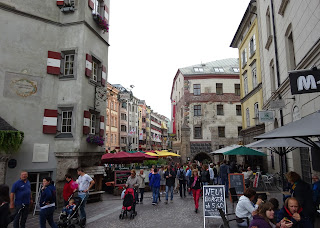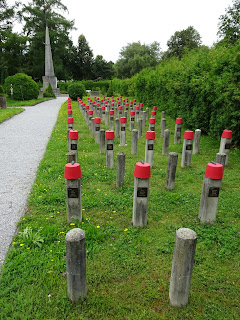Innsbruck, population 125,000, hosted the Winter Olympics in 1964 and again in 1976. It's August and the temperature is only in the mid-60's but, the next day shoots up to 90 degrees.
The old town area is swarming with tourists admiring the colorful buildings.
More of the old town.
The Inn river barrels past downtown Innsbruck--which pretty much explains how the city got its name.
This ski jump, within walking distance to the city center, was used in both Winter Olympics
This colorful church was formerly part of a monastery complex. Several former monasteries can still be found within Innsbruck's city limits.
I came across this waste removal truck parked on a side street. Scratching my head to figure out why the owner of this business decided to put those words in English instead German, the local language.
High on a hill overlooking Innsbruck one can barely make out Ambras castle.
The 10th century castle was rebuilt in the 16th century on the orders of Archduke Ferdinand ll.
The Archduke's renovated Ambras castle (in Renaissance style) allowed him to accommodate his world-famous art collection in a museum specially built for that purpose. In doing so Archduke Ferdinand ll unknowingly became part of historic trivia: Castle Ambras Innsbruck is the oldest museum in the world.
As you know, I love to visit cemeteries. This is one of Innsbruck's biggest.
However, just across from the main cemetery I find this quiet military cemetery. In this section each headstone bears the year 1799. Wow, that's during the Napoleonic Wars.
All the graves in this section are stamped with the year 1918.
Here, I count over 500 concrete tombstones, each bearing the year 1918 AND all have Italian names--evidently there was a battle in the area.
Also from World War l, most of these unusual headstones sport a red fez, a felt headdress traditionally worn by the Turkish army.















No comments:
Post a Comment